Welcome to Nagano, a prefecture renowned for its breathtaking landscapes and rich cultural heritage.
This blog post explores the 10 best beautiful places in Nagano, each offering a unique blend of natural beauty and historical significance.
From the pristine highlands of Kamikochi to the historic charm of Matsumoto Castle, join us as we uncover the diverse and stunning attractions that make Nagano a must-visit destination in Japan.
Whether you’re an avid skier, a nature lover, or a history enthusiast, Nagano’s top sights promise memorable experiences amidst some of the country’s most spectacular scenery.
- Recommended BEST Tours in Nagano
- Recommended Nagano Hotels
- Cheap Flights, Airline Tickets & Plane Tickets (TRIP.COM)
Number 10: Obuse.
Starting our countdown at number 10, the enchanting town of Obuse, often dubbed a hidden gem in the heart of Nagano Prefecture. This charming town is not just a place; it’s a delightful experience that encapsulates the essence of Japanese culture, art, and culinary excellence. Famous for being the residence of Katsushika Hokusai, one of Japan’s most celebrated artists, during his prolific later years, Obuse retains a deep artistic heritage that continues to captivate visitors.
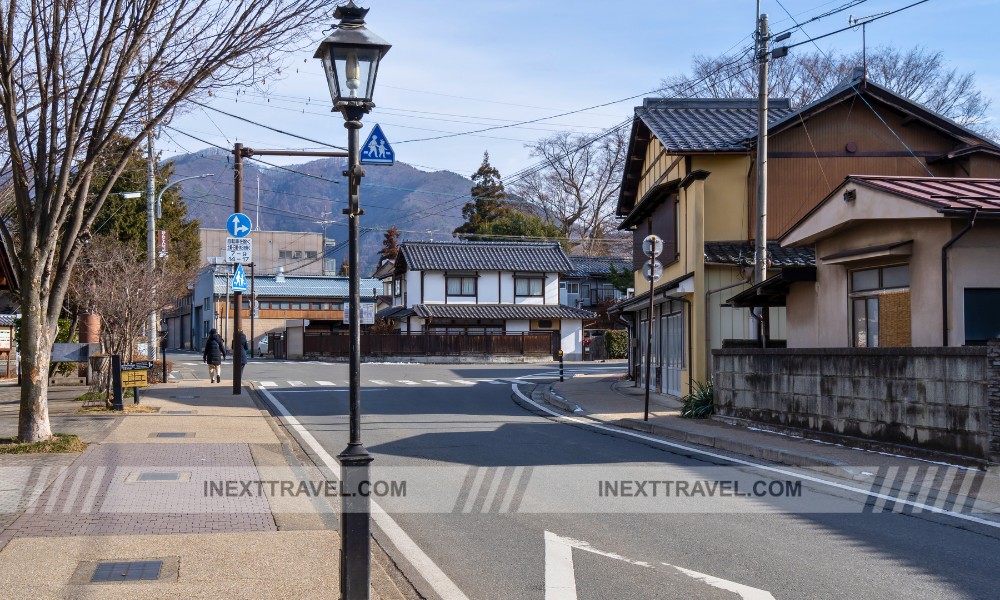
Obuse is renowned for its chestnuts, which are considered among Japan’s best. The town takes pride in its various chestnut-based delicacies, from sweet chestnut pastes in desserts to chestnut-infused savory dishes that highlight local culinary traditions. Walking through Obuse, visitors will encounter numerous cafes and shops offering an array of these chestnut treats, making it a gastronomic paradise for those eager to explore unique local flavors.
The town also boasts several museums and galleries, including the Hokusai Museum. This museum is dedicated to the life and work of Hokusai, featuring many of his renowned woodblock prints and paintings, along with works by other artists influenced by his legacy. The integration of art into the town’s culture is palpable, with beautifully decorated shop fronts and public spaces that reflect its residents’ appreciation for aesthetic beauty.
Adding to its charm are the well-preserved streetscapes that echo the town’s rich history. These streets are lined with traditional houses and shops that have been carefully maintained or restored, offering a picturesque backdrop that feels like stepping back in time. Obuse’s inviting atmosphere is further enhanced by its community of welcoming locals, who are proud of their heritage and eager to share it with visitors.
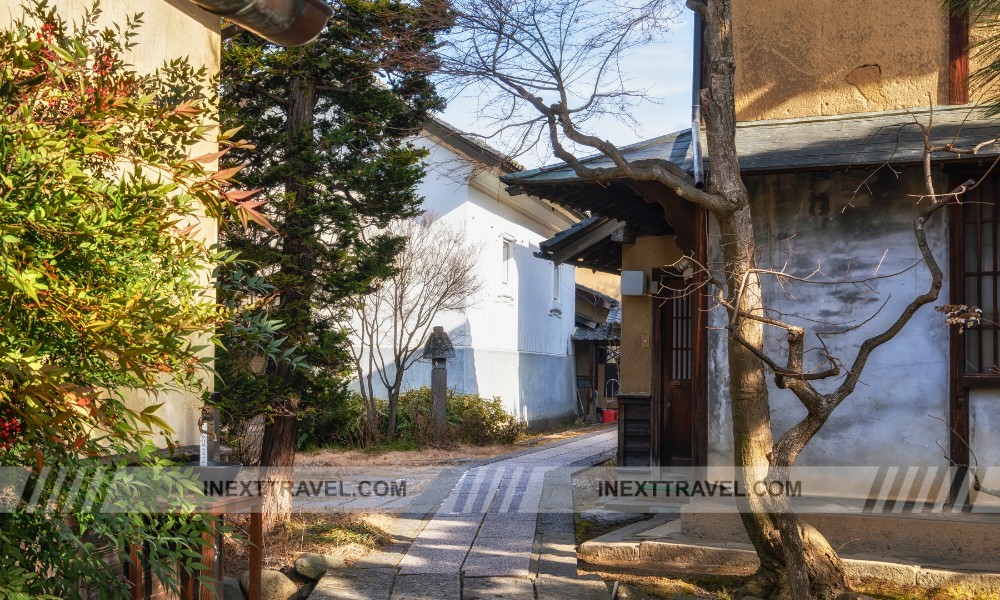
Festivals and cultural events are a staple in Obuse, celebrating everything from art and history to chestnuts and sake. These events provide an excellent opportunity for visitors to engage with the local culture, participate in traditional festivities, and enjoy the communal spirit that pervades the town.
In summary, Obuse is more than just a stop on the map; it is a vibrant cultural hub where art, history, and gastronomy intermingle seamlessly in a quaint and inviting setting. Obuse offers a unique and enriching experience for anyone visiting Nagano that showcases the best of what rural Japan has to offer, making it a deserving candidate for one of the best beautiful places in Nagano.
Number 9: Togakushi Shrine.
At number 9, Togakushi Shrine is a profound spiritual retreat in Nagano’s lush woodlands. This ancient Shinto shrine complex, composed of five significant shrines spread across the scenic Togakushi mountain range, offers a rich blend of spiritual significance and natural beauty. The shrine’s location, surrounded by towering, centuries-old cedar trees, creates a serene and almost otherworldly atmosphere that captivates visitors and provides a deep sense of tranquility.
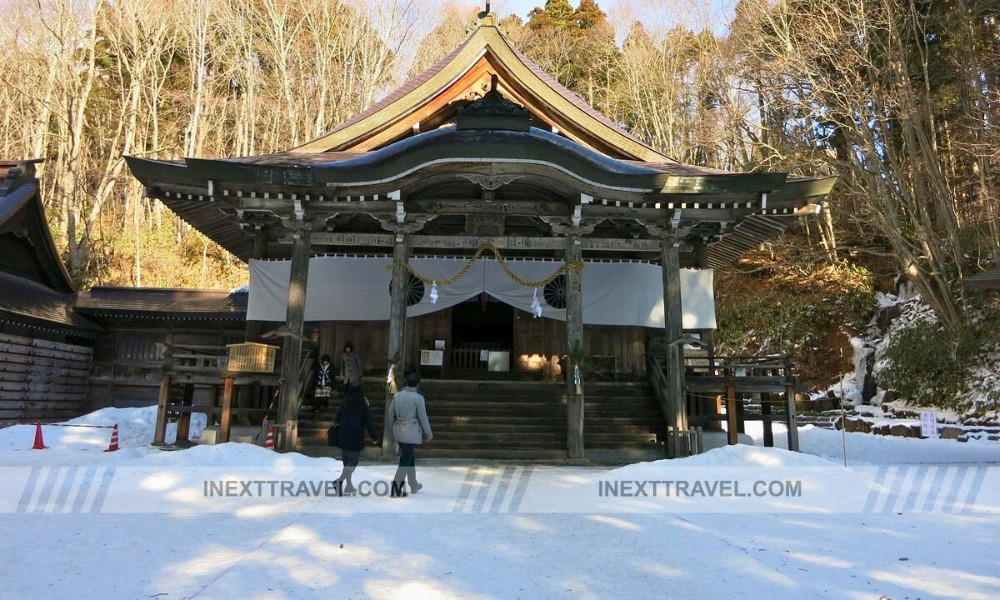
Togakushi Shrine is steeped in mythology and history, dating back over 2,000 years. It is closely tied to the legend of the Sun Goddess Amaterasu and the Heavenly Cave, making it a site of profound mythological importance in Shinto belief. This historical depth adds a layer of mystique and reverence to the shrine, drawing pilgrims and culture enthusiasts alike to explore its sacred grounds.
The approach to the shrine is an experience in itself—a majestic path lined with ancient cedars that stretches for nearly two kilometers, leading visitors through a natural gateway that transitions them from the earthly to the spiritual world. This path is a physical journey and a symbolic passage, cleansing the mind and preparing the spirit for communion with the divine.
Each of the five shrines within the Togakushi complex has its unique character and significance, from the lower shrine, which is easily accessible and often the starting point for visitors, to the upper shrine, which requires a hike through beautiful forested trails, offering rewarding views and a more intimate connection with nature. The journey between these shrines is punctuated with stunning vistas, small waterfalls, and spots perfect for reflection and meditation.
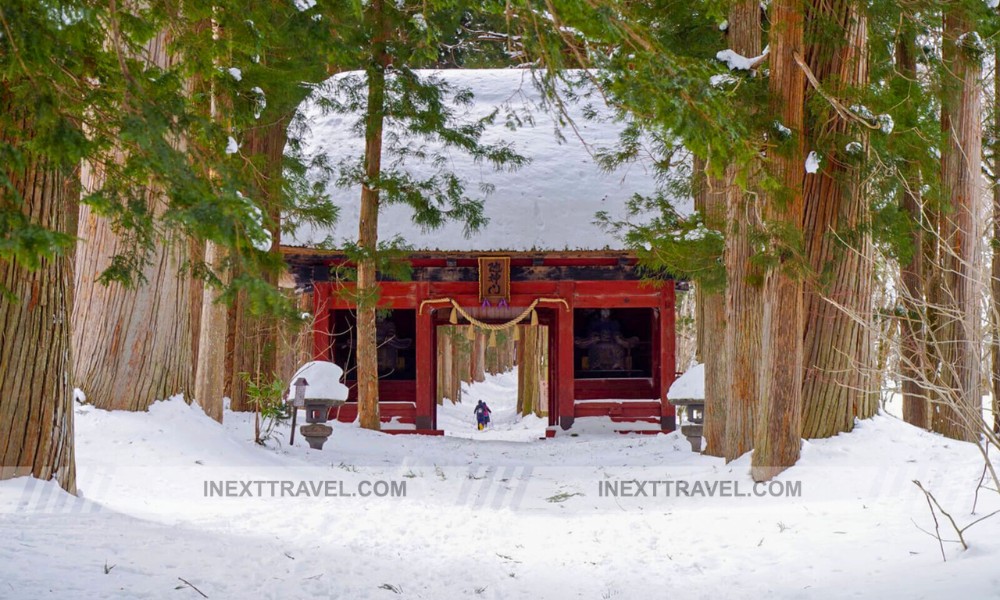
In addition to its spiritual heritage, the Togakushi Shrine is also famous for its connection to the Togakure-ryu school of ninjutsu, adding an element of intrigue and cultural richness to the visitor experience. The nearby Ninja Museum and themed attractions further celebrate this aspect of Togakushi’s history, providing educational and entertaining insights into the life and practices of ninjas.
Visiting Togakushi Shrine is thus more than a simple sightseeing trip; it is an immersive experience that combines spiritual enrichment, historical exploration, and natural beauty. It offers a unique opportunity to delve into the heart of Nagano’s mystical woodlands and experience the rich tapestry of Shinto traditions in a timeless setting. This makes Togakushi Shrine a must-visit spiritual site and one of the most beautiful places in Nagano.
Number 8: Jigokudani Monkey Park.
At number 8, Jigokudani Monkey Park offers a truly unique and enchanting wildlife experience nestled within the snowy landscapes of Nagano. This park is famous worldwide for its wild population of Japanese macaques, commonly called snow monkeys, known to bathe in the park’s natural hot springs during the cold winter months. This extraordinary behavior, not observed anywhere else in the world where monkeys live in the wild, provides a fascinating glimpse into the adaptive behaviors of wildlife and the natural wonders of Nagano.
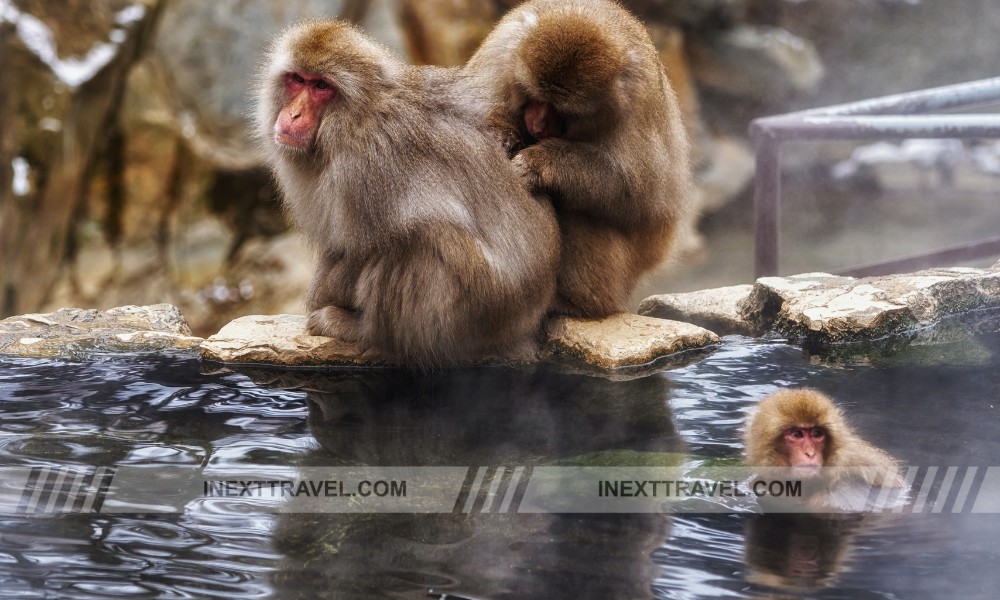
Located in the valleys of the Yokoyu River, the park gets its name, Jigokudani (Hell Valley), from the steam and boiling water that bubbles out of small crevices in the frozen ground, surrounded by cliffs and formidably cold and barren forests. These harsh conditions led the monkeys to seek warmth in the soothing waters of the hot springs, creating a surreal and photogenic scene that has captured the imagination of photographers and wildlife enthusiasts from around the globe.
Visiting Jigokudani Monkey Park allows guests to observe the snow monkeys up close as they soak in the hot springs, groom each other, play, and learn about their social structures and behaviors in a natural setting. The park has pathways and viewing platforms designed to minimize human impact on the natural habitat while providing visitors with excellent viewing opportunities.
Beyond its appeal as a unique tourist attraction, the park plays a crucial role in studying and conservating the Japanese macaque. Despite being numerous, the macaque faces challenges due to habitat loss and human encroachment. The park helps raise awareness about these issues and promotes conservation efforts.

The experience of visiting Jigokudani Monkey Park is enhanced by the stunning natural beauty of the surrounding area, which offers year-round recreational activities. In winter, the snow-covered landscape provides a picturesque backdrop to the steaming springs and bathing monkeys. At the same time, in the warmer months, the lush greenery and vibrant life in the forests offer a refreshing contrast.
Overall, Jigokudani Monkey Park is not just a place to see unusual animal behavior but a destination that offers insights into wildlife resilience and the beauty of natural adaptation. It stands as a testament to the unique interactions between Nagano’s natural elements and wildlife, making it one of the region’s best places to connect profoundly with nature.
Number 7: Kiso Valley.
Coming in at number 7, Kiso Valley stands as a captivating portal to Japan’s past, perfectly preserved amidst the lush mountains of Nagano. This valley is renowned for its section of the Nakasendo trail, an ancient highway that once connected Kyoto to Edo (modern-day Tokyo) during the Edo period. The valley’s preservation of the historic post towns, particularly Tsumago and Magome, offers a vivid and authentic glimpse into life along this vital trade route centuries ago.
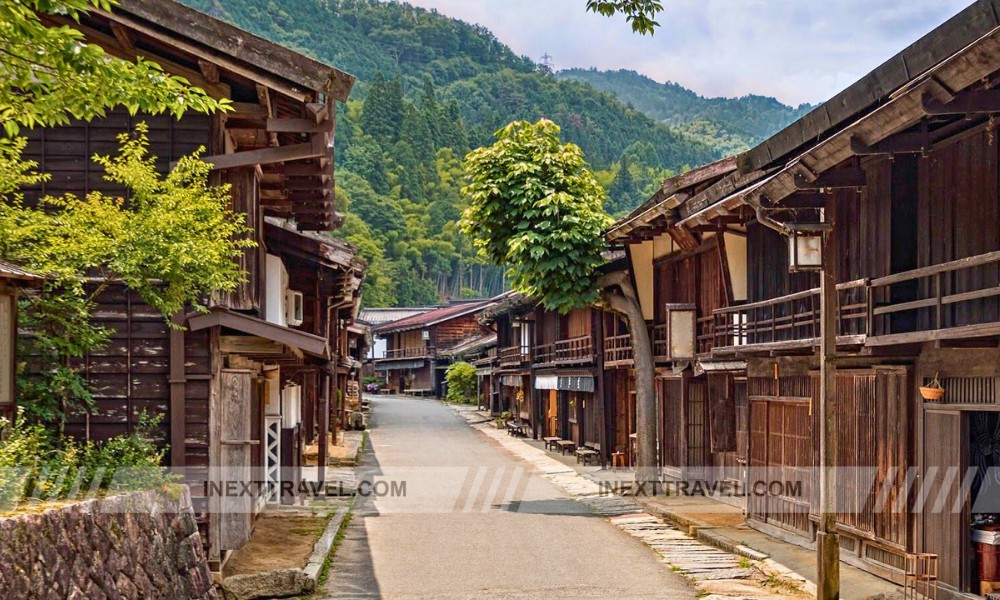
Kiso Valley’s appeal lies in its natural beauty and the meticulous restoration and preservation of its post-towns. Walking through Tsumago and Magome, visitors are transported back to a time when samurai, merchants, and travelers roamed these streets. The towns are free of modern vehicles, power lines, and overt commercial signage, maintaining historical integrity and serenity. Traditional wooden inns, teahouses, and shops line the cobblestone streets, while residents dress in period attire to enhance the authentic experience.
The area is particularly famous for the well-maintained Nakasendo trail section that connects Tsumago to Magome. This trail offers a gentle walk through scenic countryside, past waterfalls, rice fields, and wooded areas, allowing hikers to experience the same landscapes travelers saw hundreds of years ago. Along the way, old tea houses provide rest and refreshment just as they did in the past, serving traditional fare and offering a taste of the local hospitality.
Moreover, the Kiso Valley is about historical preservation and cultural immersion. The local communities engage in various cultural events and festivals that celebrate and share their heritage with visitors. These include demonstrations of traditional crafts, samurai performances, and seasonal festivals that bring to life the customs and traditions of the Edo period.
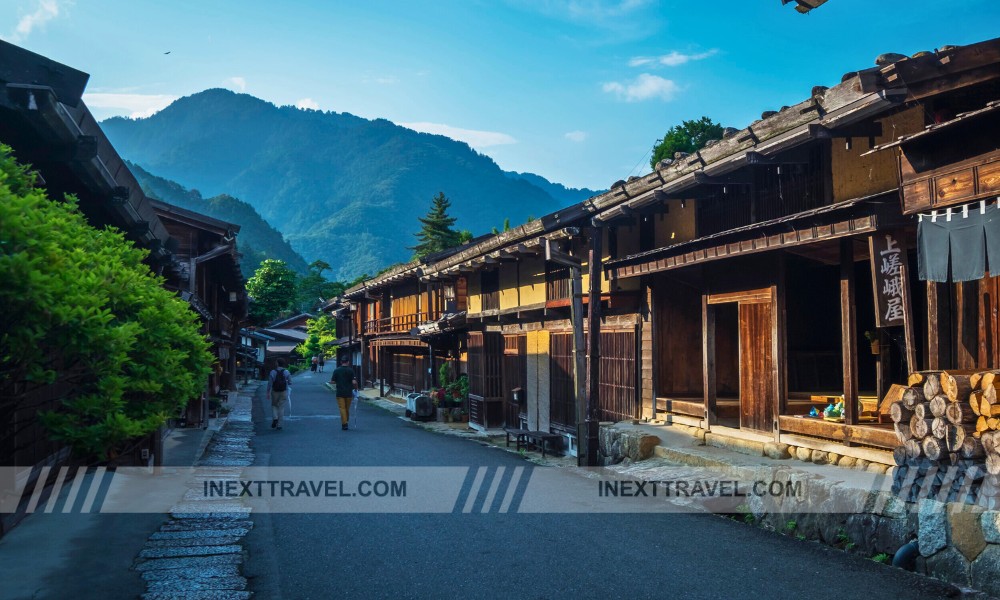
In addition to its historical and cultural significance, Kiso Valley’s natural surroundings provide a tranquil backdrop that enhances its timeless appeal. The valley’s lush forests and clear rivers give a sense of peace and continuity with nature, making it an ideal destination for those seeking historical insight and natural beauty.
In summary, Kiso Valley is more than just a place; it’s an experience that captures the essence of Japan’s cultural and historical spirit. It provides an opportunity to see and feel, walk, and breathe in a living museum of Japan’s storied past, making it one of the best beautiful places in Nagano for history enthusiasts and nature lovers alike.
Number 6: Lake Suwa.
At number 6, Lake Suwa, a gem in the heart of Nagano, captivates visitors with its natural beauty and intriguing phenomena. This lake is not only a central feature of the region’s landscape but also a place steeped in myth and tradition, most famously known for the phenomenon of Omiwatari. This natural occurrence occurs in the winter when the lake’s surface ice cracks and refreezes, forming stunning ice ridges that are said to be the path of the gods crossing the lake. According to local legend, these ridges are created by the deity of Suwa Shrine walking across the ice to visit the goddess of the opposing shore.
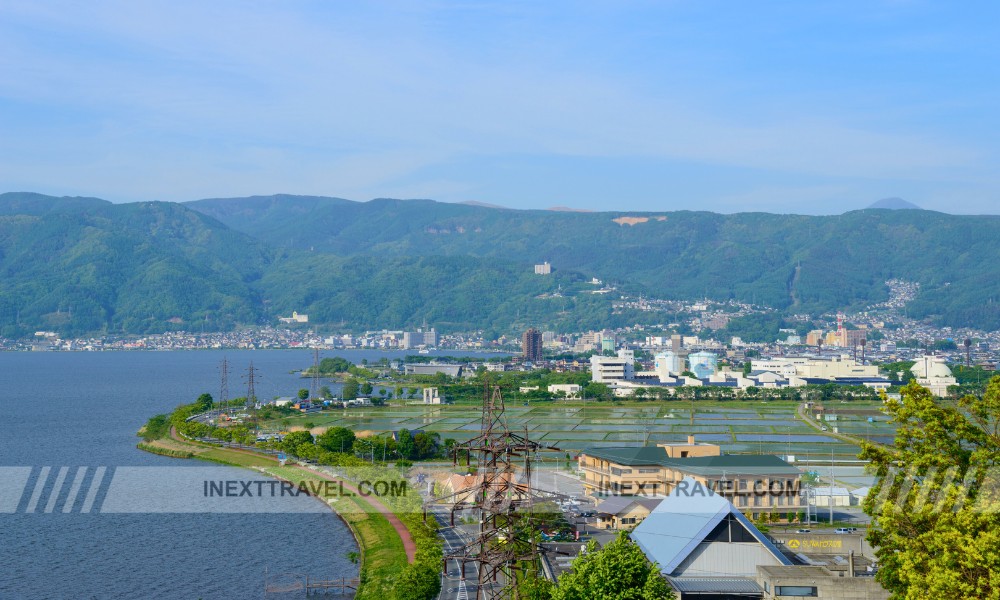
The spectacle of Omiwatari is a powerful draw for visitors, who come to witness this rare natural event that intertwines with local folklore, adding a layer of mystical allure to the lake’s winter landscape. During this season, the lake transforms into a frosty expanse, offering a serene and otherworldly scene that contrasts sharply with its summer vibrancy.
In the warmer months, Lake Suwa becomes a hub of activity and celebration, particularly during its spectacular fireworks festival. This event, one of Japan’s largest and most renowned, lights up the summer nights with dazzling displays that reflect over the lake’s surface, creating a mesmerizing spectacle. The festival attracts tourists from across Japan and beyond and serves as a vibrant testament to the community’s spirit and heritage.
Beyond its seasonal phenomena, Lake Suwa is a focal point for year-round recreation. It is encircled by a scenic promenade famous for walking, jogging, and cycling, offering panoramic views of the surrounding mountains and the peaceful waters. The lake area is also equipped with several hot springs, where visitors can relax and enjoy the therapeutic benefits of natural mineral waters, further enhancing the appeal of Lake Suwa as a destination for relaxation and rejuvenation.
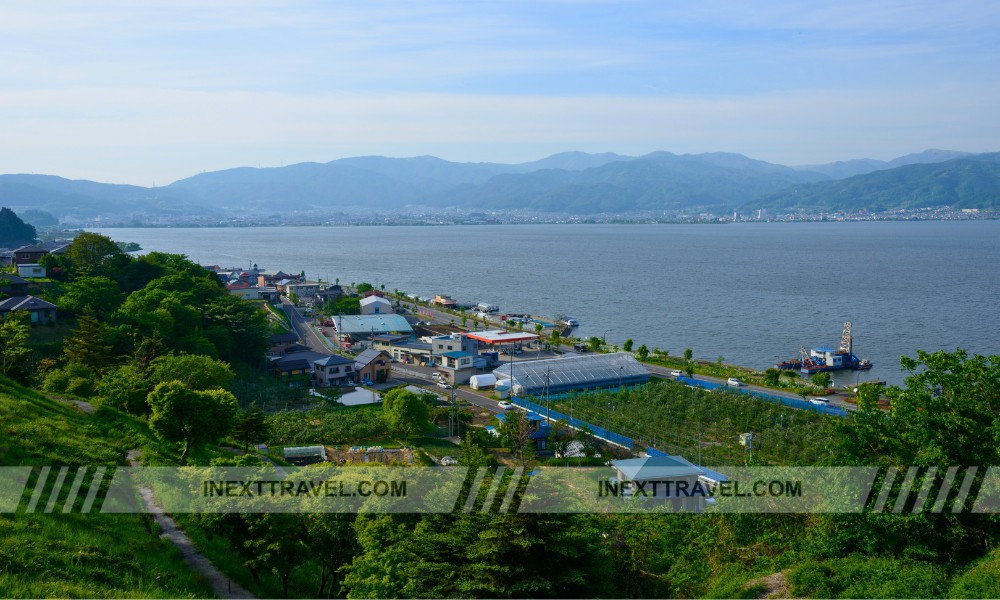
The cultural importance of Lake Suwa is also highlighted by the presence of several historic sites and temples along its shores, which offer insight into the region’s rich history and the spiritual significance of the lake in local religion. These sites, along with the lake’s natural beauty and unique phenomena, make Lake Suwa an essential destination for anyone visiting Nagano, offering a blend of natural wonder, cultural depth, and recreational enjoyment that ranks it among the best beautiful places in the region.
Number 5: Zenkoji Temple.
Number 5 on our list is Zenkoji Temple, one of Japan’s most cherished and historically significant Buddhist temples. Located in the heart of Nagano, this revered temple attracts millions of pilgrims and tourists each year, drawn by its deep spiritual significance and architectural beauty. Zenkoji is known for its promise of salvation to all visitors, irrespective of their religious beliefs, making it a beacon of inclusivity and spiritual solace.
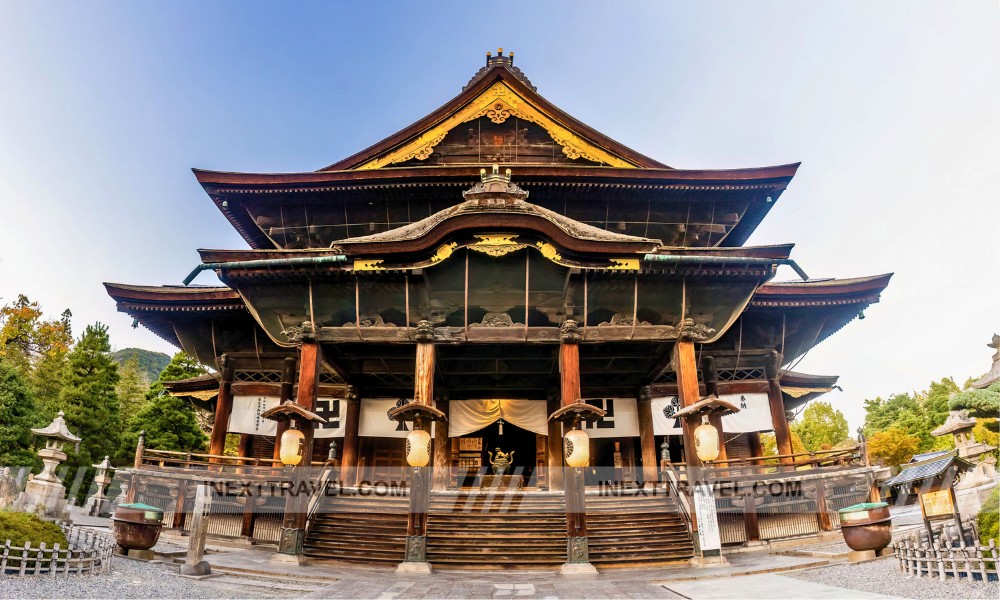
The temple’s history dates back to the 7th century, making it one of the oldest Buddhist temples in Japan. It houses the first Buddhist statue ever brought to Japan, a sacred image that is completely hidden from public view. It is revealed only once every six years during the Gokaicho ceremony. This event draws many devotees who come to seek blessings and witness the replica of the hidden image, believing it will grant them salvation.
Zenkoji’s main hall, designated national treasure, is a stunning example of traditional Japanese temple architecture. Its grand scale and elaborate wood carvings are a testament to Japan’s ancient builders’ craftsmanship and artistic prowess. The structure has been preserved and restored over the centuries to maintain its historical integrity and aesthetic appeal. Walking through the massive wooden gates and into the serene environs of the temple complex, visitors can feel a palpable sense of history and spirituality.
The approach to the temple, known as the Nakamise-dori, is a charming street lined with shops and stalls selling religious artifacts, local crafts, and traditional foods. This street provides a lively and colorful lead-up to the temple, enhancing the pilgrimage experience with a taste of local culture and hospitality.
Zenkoji also plays a crucial role in the community, hosting numerous cultural and religious events yearly that celebrate and uphold Buddhist traditions. These events offer visitors a deeper insight into Japanese spiritual practices and community life.
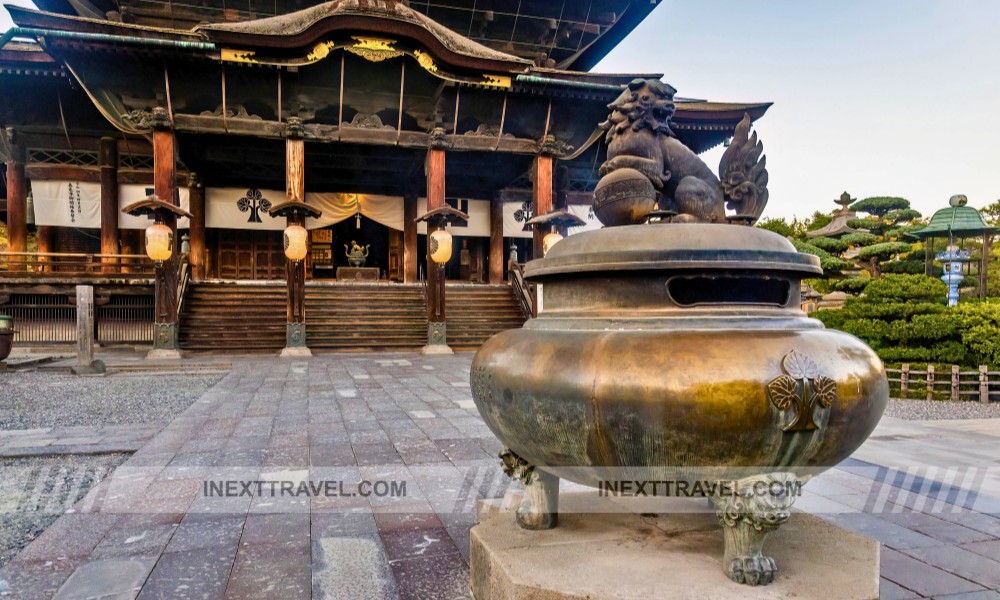
The temple’s surroundings, with well-maintained gardens and smaller ancillary temples, invite visitors to linger and explore. Each corner of the complex offers a space for reflection and meditation, supported by the peaceful, welcoming atmosphere that pervades the area.
The Zenkoji Temple is a monument of great historical and architectural significance and a living center of faith and culture. Its promise of salvation and stunning beauty make it one of the best places in Nagano, offering a profound and enriching experience to all who walk its sacred grounds.
Number 4: Shiga Kogen.
At number 4, Shiga Kogen stands out as a premier destination for ski enthusiasts, nature lovers, and adventure seekers. This highland area is located within the expansive Joshinetsu Kogen National Park, Japan’s largest ski resort. It boasts an impressive array of ski slopes that cater to all levels of skiers and snowboarders. With its diverse terrain and reliable snow, Shiga Kogen hosts numerous domestic and international competitions, making it a top choice for winter sports.
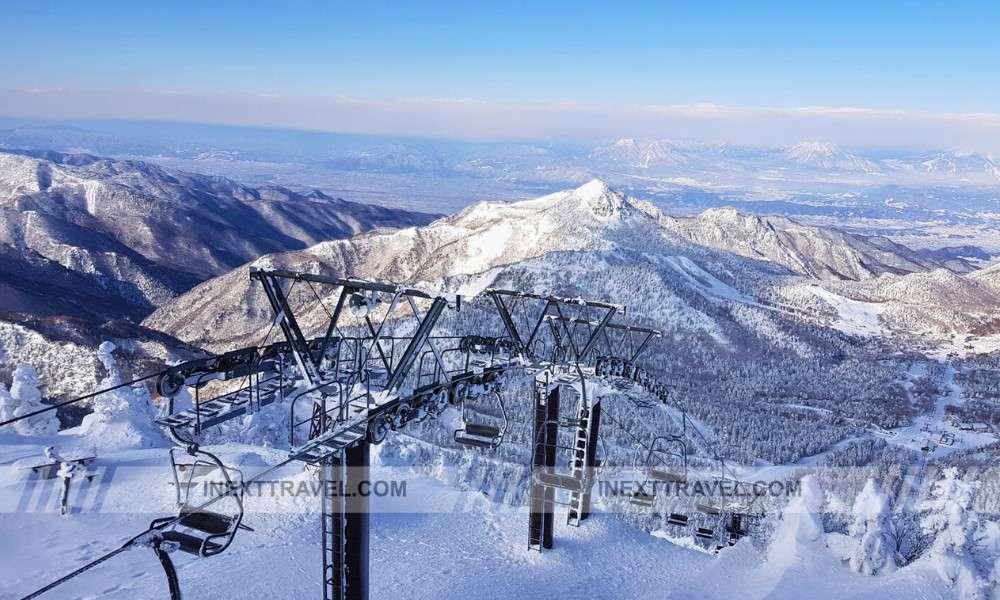
But Shiga Kogen’s appeal extends far beyond the winter months. As part of one of Japan’s most significant national parks, it is a vital habitat for various wildlife, including the Japanese macaque, famously known as the snow monkey. These creatures can often be seen in their natural environment, particularly around the hot springs, adding a unique aspect to the area’s natural allure.
During the spring and summer, the snow-covered slopes transform into lush green landscapes, offering breathtaking scenery and many outdoor activities. Hiking, mountain biking, and bird watching become famous as the area blooms with alpine flowers and vibrant foliage, providing stunning visual contrasts and drawing nature enthusiasts from all over.
Shiga Kogen is also a fantastic place for ecological tours and educational excursions, thanks to its rich biodiversity and well-preserved ecosystems. The numerous ponds and wetlands offer serene spots for contemplation and nature observation, making it an excellent location for those interested in environmental science or photography.
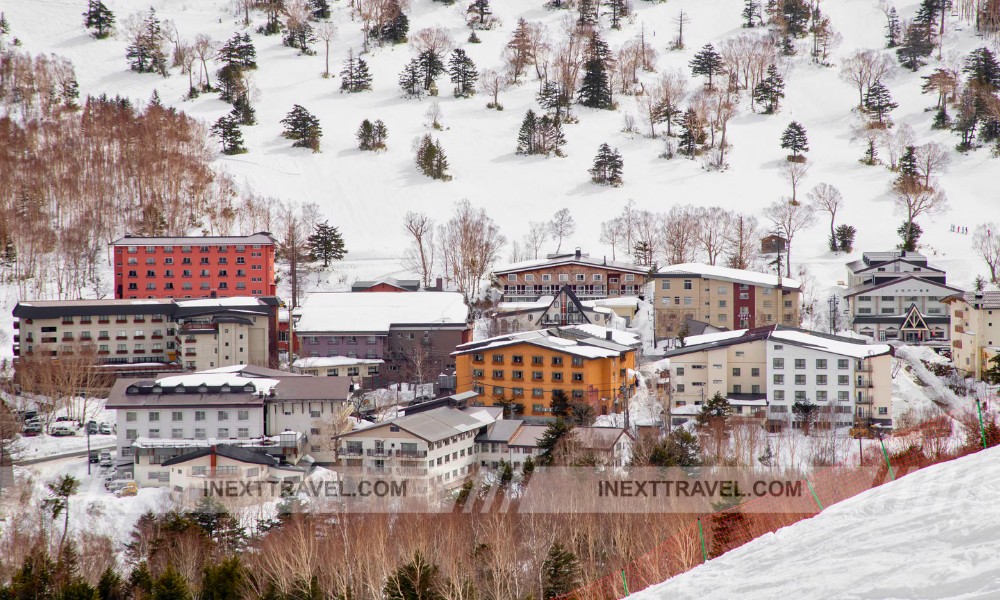
Furthermore, Shiga Kogen’s commitment to environmental preservation is evident in its careful management of tourist facilities and activities. The region promotes sustainable tourism practices to maintain its natural beauty and ecological integrity for future generations.
Overall, Shiga Kogen is one of the best places in Nagano for skiing and a year-round haven for recreation and wildlife observation. Its stunning natural beauty, combined with a wide range of activities and a strong environmental ethos, makes it a must-visit destination for anyone traveling to Nagano. It offers experiences that are both exhilarating and enriching.
Number 3: Matsumoto Castle.
Our number 3, Matsumoto Castle, is one of Japan’s most formidable and beautiful historical landmarks. Also affectionately known as ‘Crow Castle’ due to its striking black exterior, this majestic structure is one of the few remaining original castles in Japan. It offers a rare glimpse into the architectural ingenuity and military sophistication of Japan’s feudal era.
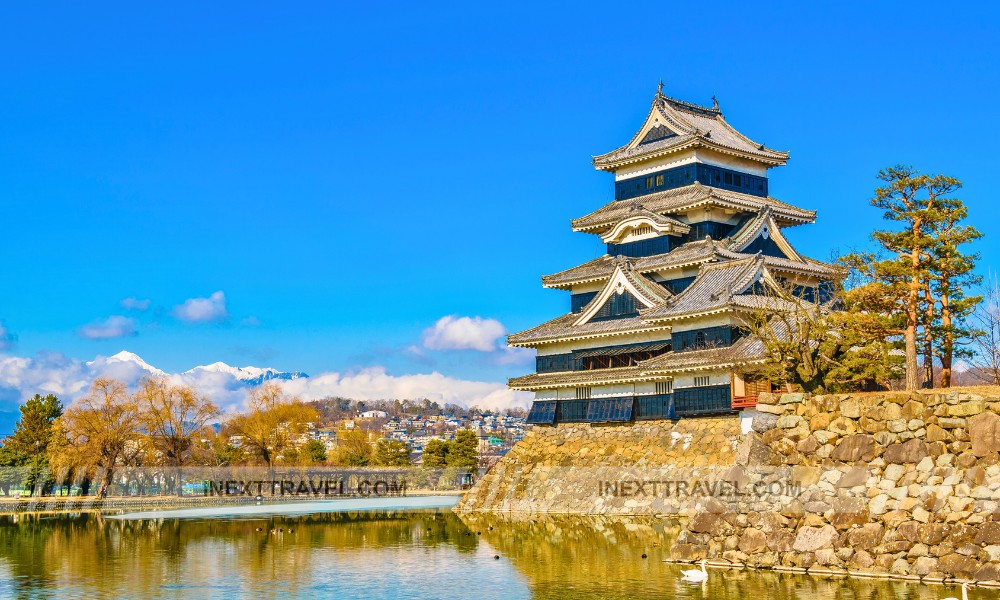
Matsumoto Castle, located in the heart of Nagano Prefecture, was constructed in the late 16th century and meticulously preserved over the centuries. Its distinctive black-and-white color scheme and elegant yet formidable structure make it an iconic symbol of power and resilience. The castle’s multi-tiered roofs and towering keep are designed for aesthetic appeal and strategic defense, featuring hidden openings for dropping stones and arrows on invaders.
The castle is surrounded by a tranquil moat and set against the backdrop of the Japan Alps, providing picturesque scenery that changes with the seasons, from cherry blossoms in spring to rich autumn leaves and snowy winter vistas. This stunning natural setting enhances the historic ambiance, making Matsumoto Castle a visually enchanting experience.
Inside, Matsumoto Castle is a museum housing an extensive collection of armor, weapons, and artifacts from the samurai era, offering visitors an immersive historical experience. The interior, with its wooden beams and steep staircases, remains unchanged from when it was first built, giving a sense of stepping back in time.
Visitors can climb to the top floor of the castle’s main keep, where they are rewarded with panoramic views of the surrounding city and mountains. This vantage point was historically used to spot approaching enemies but now provides an ideal spot for photography and sightseeing.
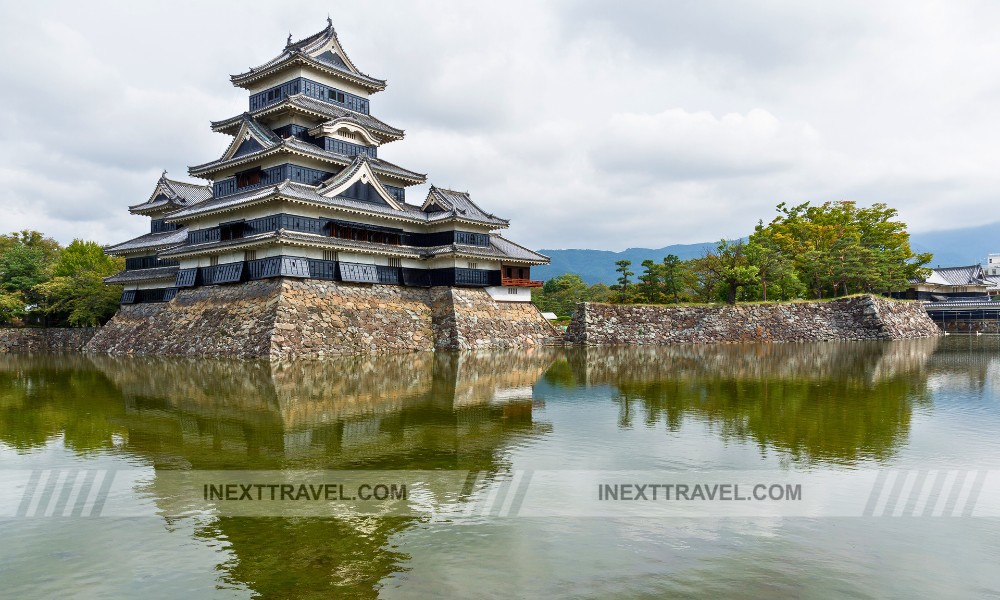
Matsumoto Castle is a testament to the craftsmanship and military prowess of feudal Japan and serves as a cultural cornerstone for the region. Various events and festivals throughout the year celebrate the castle’s history and cultural significance, attracting history buffs and casual tourists.
In summary, Matsumoto Castle is more than just an architectural marvel; it is a cultural treasure that connects deeply to Japan’s feudal past. Its preservation as one of the country’s most beautiful original castles makes it a must-visit destination in Nagano. It provides a profound historical and aesthetic experience that ranks it among the best places in the region.
Number 2: Kamikochi.
At number 2, Kamikochi is a breathtaking highland valley in the Northern Japan Alps, a part of the Chubu Sangaku National Park. Renowned for its pristine natural beauty and spectacular alpine scenery, Kamikochi represents the pinnacle of mountainous landscapes in Japan, drawing nature lovers, hikers, and photographers worldwide.
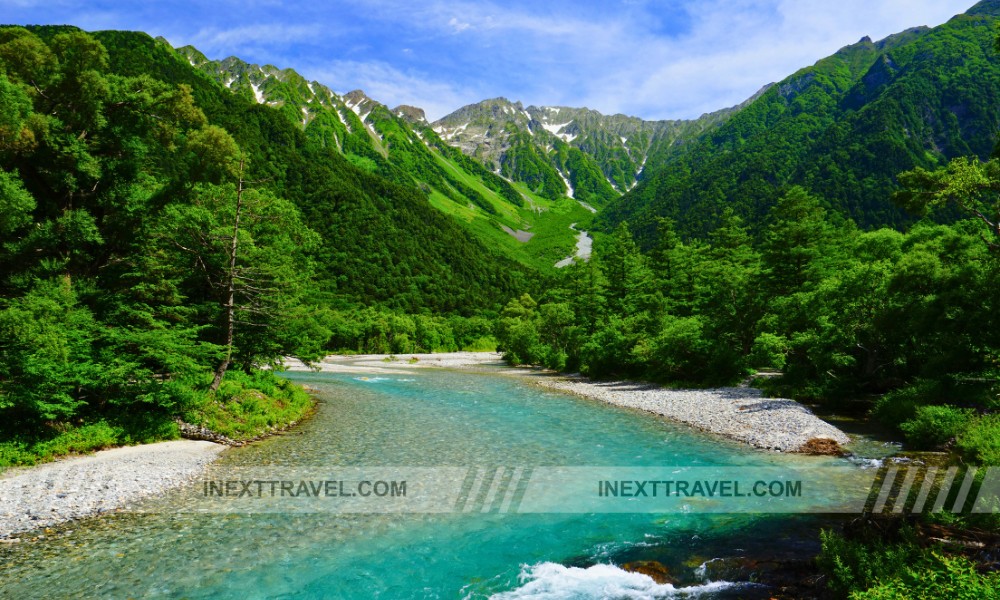
The valley features a dramatic panorama of towering peaks, including the active volcano Mount Yake, the rugged Nishihotakadake, and the majestic Oku-Hotakadake, among the highest mountains in Japan. The pristine Azusa River flows through the valley, adding to its serene beauty with crystal-clear waters that reflect the surrounding mountains like a mirror. Dense forests, rushing streams, and expansive wetlands create a diverse ecosystem where flora and fauna thrive.
Kamikochi is widely celebrated for its hiking trails, which range from easy walks suitable for families to more challenging treks for seasoned hikers. The trails are well-maintained and provide safe access to some of the most stunning vistas in the region. Popular routes include the walk to the picturesque Taisho Pond, where visitors can enjoy reflections of the mountains in its still waters, and the more demanding hike to the Dakesawa Marsh, offering panoramic views and the chance to spot wildlife.
Kamikochi’s accessibility is carefully controlled to preserve its natural environment, making it a model of sustainable tourism. Private vehicles are restricted in the area, and access is provided by bus or taxi, ensuring that the valley remains tranquil and minimally impacted by human activity. This approach allows visitors to immerse themselves fully in the peace and natural beauty of the highlands.
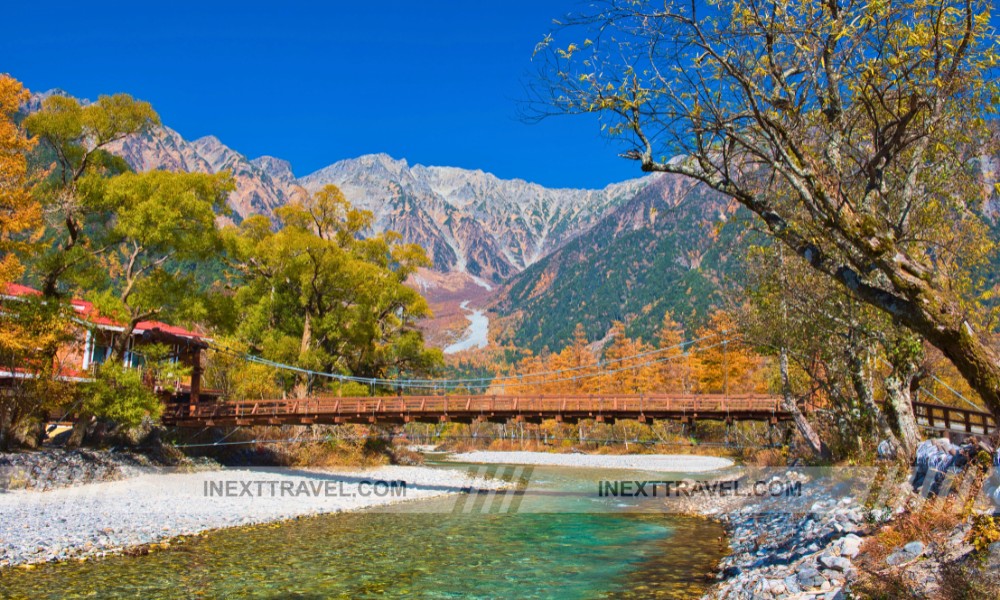
In addition to its natural attractions, Kamikochi is imbued with a sense of tranquility and spiritual significance. It has been a site of inspiration and reverence for centuries, influencing Japanese art, literature, and religion. The serene setting is often described as a place where one can connect profoundly with nature, offering moments of reflection and rejuvenation.
In summary, Kamikochi is not just a destination; it’s an experience embodying the essence of Japan’s alpine grandeur. Its stunning landscapes, diverse ecosystems, and commitment to conservation make it one of the best beautiful places in Nagano and a must-visit for anyone seeking to explore Japan’s natural wonders. Whether you are an avid hiker, a nature enthusiast, or simply searching for peace, Kamikochi offers an unparalleled mountain escape.
Number 1: Hakuba Valley.
At number one, Hakuba Valley stands as a premier destination, not just within Nagano but as a celebrated spot on the global map for winter sports enthusiasts and nature lovers alike. Renowned worldwide for its ski resorts, Hakuba distinguishes itself with impressive mountains that offer top-tier winter sports excitement and stunning green season adventures, making it a versatile destination for all seasons.
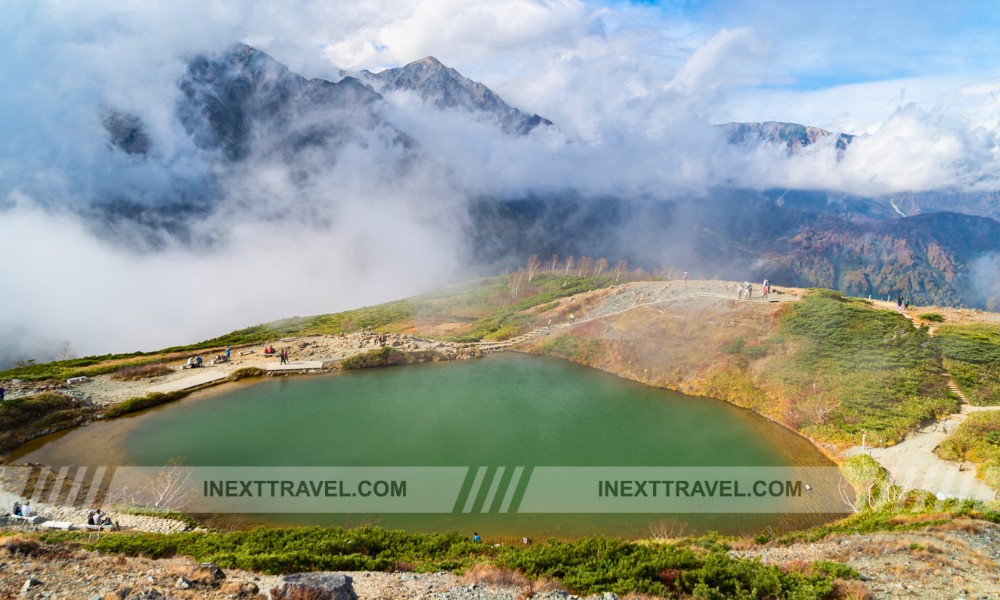
Hakuba Valley is nestled in the Northern Japan Alps and boasts some of the best ski slopes in Asia, with over 200 runs suited to every level of skier and snowboarder. During the winter months, the valley is transformed into a winter wonderland, receiving copious amounts of powdery snow, ideal for snow sports. The area hosted several events during the 1998 Nagano Winter Olympics, a testament to its outstanding facilities and slopes. The variety of terrain, excellent powder conditions, and advanced lift systems make it a haven for snow sports enthusiasts worldwide.
But Hakuba’s appeal extends far beyond the winter. As the snow melts and the valley blooms into vibrant green, it becomes a paradise for hikers, mountain bikers, and outdoor adventurers. The summer months reveal lush forests, alpine meadows, and crystal-clear mountain streams, starkly contrasting the white canvas of winter. Trails that wind through the valley and up into the surrounding peaks provide spectacular views and connect hikers to the region’s natural beauty. These trails range from gentle walks suitable for families to more challenging treks for severe hikers, such as the ascent to the peaks of the surrounding mountains, including the iconic Mount Shirouma.
The valley also features pristine lakes and rivers, ideal for fishing, canoeing, and rafting, enhancing its reputation as a hub for outdoor sports and activities. Additionally, Hakuba is rich in cultural experiences, offering visitors a glimpse into traditional Japanese alpine life. Local festivals, museums, and markets allow visitors to immerse themselves in the local culture, cuisine, and community.
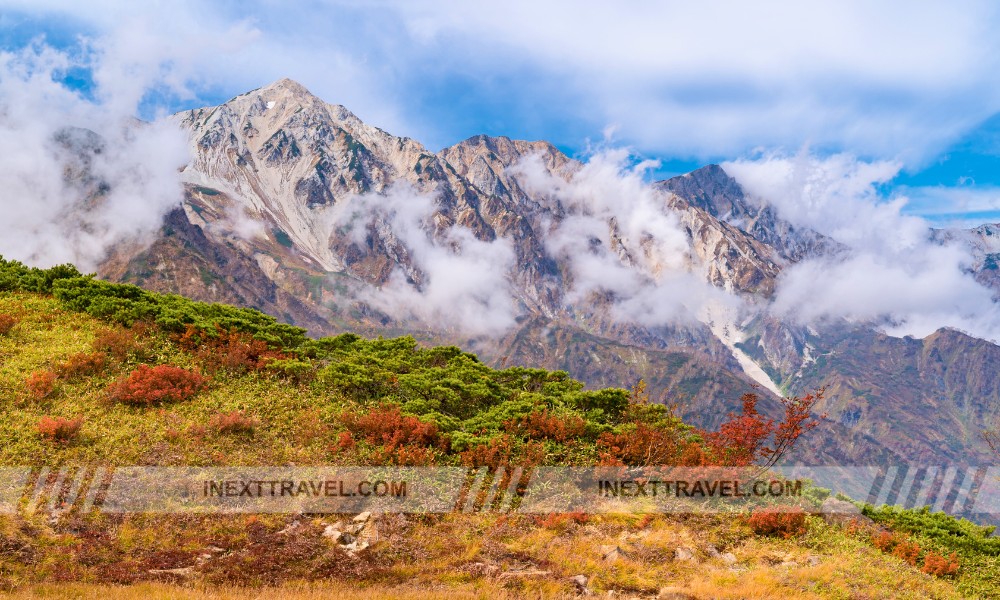
Environmental sustainability is a critical focus in Hakuba, with efforts to preserve the valley’s natural beauty and integrity. This commitment ensures that the breathtaking landscapes remain unspoiled and that Hakuba remains a sustainable destination for future generations.
In summary, Hakuba Valley is not just the best beautiful place in Nagano for its scenic vistas or sporting opportunities; it represents a harmonious blend of nature, adventure, and culture. Its world-class ski slopes and vibrant green season activities, backed by a commitment to environmental stewardship and cultural richness, make Hakuba Valley a truly exceptional destination that stands out all year round. Whether covered in snow or bathed in sunshine, Hakuba Valley offers unforgettable experiences that draw visitors back time and time again.
Conclusion
As we conclude our journey through the ten best beautiful places in Nagano, it’s clear that this region offers more than just stunning landscapes and rich history; it provides a gateway to experiences that resonate with anyone seeking adventure, tranquility, or a deeper connection with nature and culture.
From Hakuba Valley’s snowy slopes to Lake Suwa’s serene waters and the ancient pathways of the Togakushi Shrine, Nagano invites travelers to explore and cherish its diverse offerings.
Each destination we’ve visited tells a unique story, painting a picture of a region deeply connected to its natural environment and cultural roots.
Whether you are trekking through the alpine beauty of Kamikochi, soaking in the historic atmosphere of Matsumoto Castle, or experiencing the warm waters and cultural rituals of Arima Onsen, Nagano offers an array of experiences that captivate and enchant.
We hope this guide inspires you to discover these beautiful places, each a testament to Nagano’s allure. So pack your bags, set your itinerary, and prepare to immerse yourself in Nagano’s beauty and spirit.
Whether visiting in the flush of spring, the lushness of summer, the colors of fall, or the crispness of winter, Nagano’s doors are always open, promising unforgettable adventures in one of Japan’s most beautiful regions.